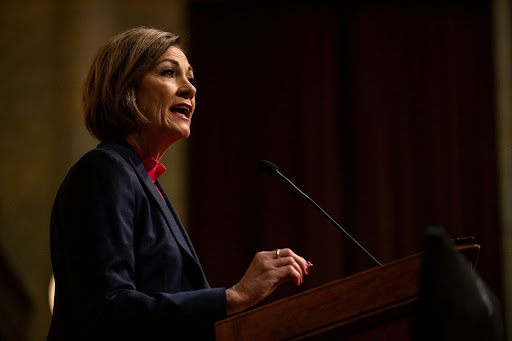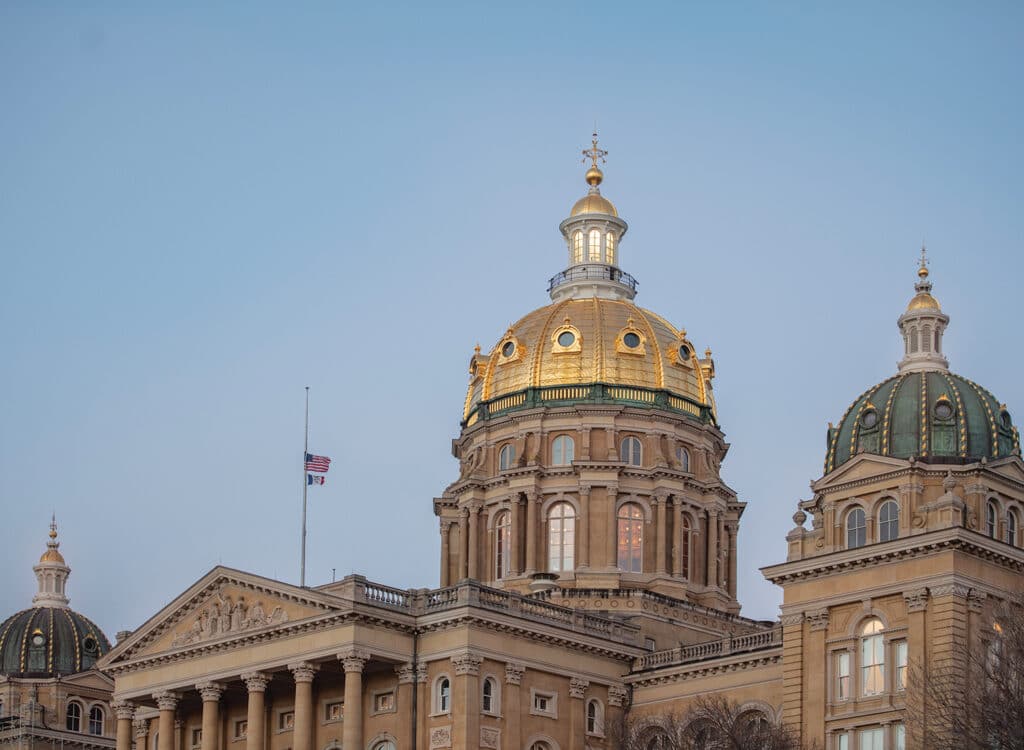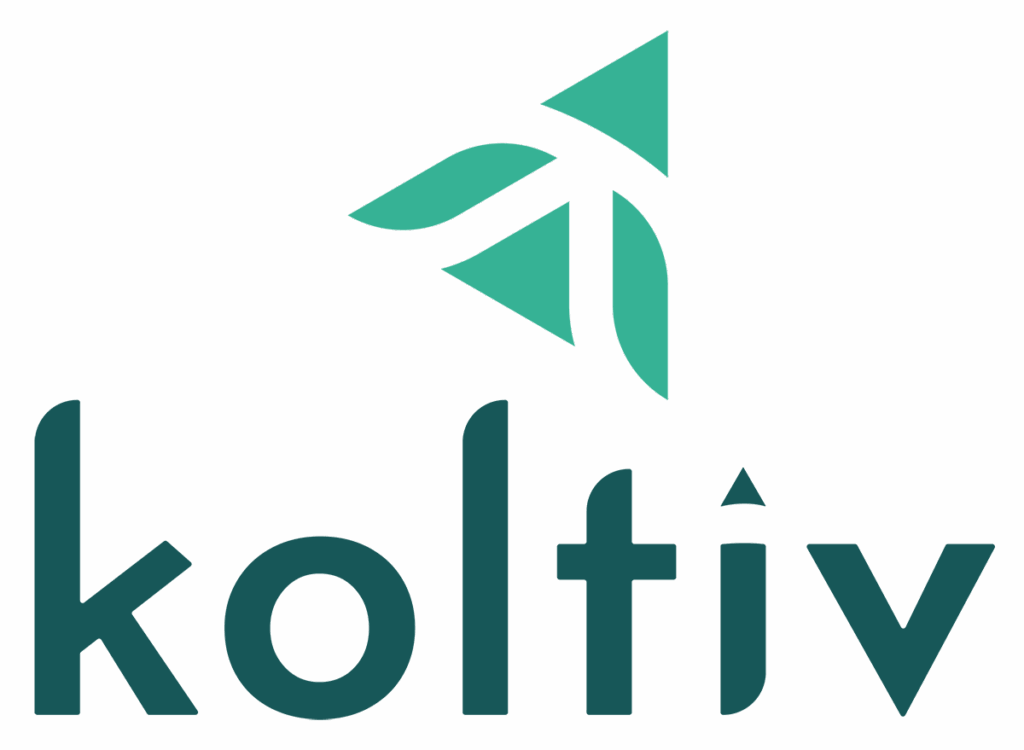Reynolds calls for flat income tax rate, revamping of unemployment system in Condition of the State

MICHAEL CRUMB Jan 12, 2022 | 4:55 pm
6 min read time
1,348 wordsAll Latest News, Government Policy and LawGov. Kim Reynolds delivers her Condition of the State speech Tuesday night in the Iowa House of Representatives. Photo by Kelsey Kremer, Des Moines Register.
Gov. Kim Reynolds proposed restructuring the state’s tax system, eliminating a complex series of tax brackets in favor of a flat 4% rate for all individual income taxpayers Tuesday in her Condition of the State address where she focused on bolstering the state’s workforce.
Reynolds, who touted the condition of the state as “strong,” also offered plans to revamp Iowa’s unemployment system with the creation of a reemployment division that will help unemployed workers connect with employers, the creation of teacher and health care apprenticeship programs, and continued investment to increase access to quality, affordable child care, among other things.
Reynolds’ speech took place in the Iowa House of Representatives, where the GOP controls the chamber by a 60-40 margin. In the Senate, Republicans hold a 32-18 edge over Democrats.
Some lawmakers and business leaders have prioritized continued reduction of the income tax or eliminating it altogether as a tool to draw more people to Iowa, and Reynolds’ proposal may be a compromise.
Iowa’s individual income tax rate has been reduced from about 9% five years ago to about 6.5%. According to the nonpartisan Tax Foundation, that ranks Iowa 38th out of 50 states, which some lawmakers and business leaders say leaves the state unable to compete for new workers.
Reynolds said the state ended last year with a $1.2 billion budget surplus and nearly $1 billion in cash reserves, something some lawmakers say would offset any revenue lost by a tax cut, at least in the short term.
In her speech, Reynolds said the cuts would occur gradually over the next four years so that priorities such as education and public safety would be protected. In the first year, Reynolds said taxpayers would save almost $500 million. Once the plan was fully implemented by 2026, an average Iowa family would pay about $1,300 less in taxes, on top of the $1,000 tax cut they received in 2018, Reynolds said.
“We’re still taking too much from Iowans’ paychecks,” she said “That needs to stop. Now.”
While that will mean less money available to the state, it will mean more money on Main Street, Reynolds said.
“We’ll see it spent in businesses instead of on bureaucracies,” she said.
According to Reynolds, her plan would also eliminate taxes on retirement income, including the tax on cash-rent payments farmers receive when they retire, and on the sale of company stocks employees receive while they work.
Reynolds said the tax cuts are designed to reward work at a time when the state and the country are facing “an unprecedented worker shortage.”
She said that job openings far outnumber the workers available to fill them, and that 4 million fewer people are working today than before the pandemic.
Unemployment changes
Reynolds proposed reducing unemployment benefits from six months to about four months, saying expanded unemployment and stimulus checks have turned a safety net into a “hammock.”
“When work begins to seem optional rather than fundamental, then society begins to decay,” she said. “I’m worried that we’re reaching that point. Where workers who stay home are being put ahead of the workers who show up.”
Reynolds’ plan also includes the creation of a separate reemployment division whose sole focus would be to match unemployed Iowans with jobs.
She said while programs such as Future Ready Iowa have helped people get back to work by providing free community college tuition for high-demand jobs, expanded apprenticeship programs and more work-based learning opportunities in schools, “barriers to work still exist, including the need for child care.”
She said the Child Care Challenge, created last year, allows child care providers to apply for grants and it’s already seeing results with grants being awarded for projects that will create 4,000 new openings for child care statewide.
Reynolds said some of the recommendations from her Child Care Task Force are already being implemented, including the easing of some regulations on providers.
“[But] there’s more to do … because no one should be forced to choose between earning a living and caring for their child,” she said.
Education
The governor also proposed the creation of what she said would be the country’s first registered teacher apprenticeship program.
High school apprentices would begin their junior year and would receive paraeducator credentials and associate degrees within a year after graduating. The time paraeducators spend in the classroom would count toward student teaching requirements, reducing the time and cost needed to become a licensed teacher, Reynolds said.
Fifty-six percent of the state spending goes to public education. For pre-kindergarten through high school, that is about $3.7 billion.
Reynolds said that while that works for most families, for others, their school district doesn’t meet their child’s needs and the state should rectify that by making sure parents are in charge of their child’s education.
That includes the introduction of legislation that will allow middle- and low-income families and students with individualized educational plans to receive a portion of the per-pupil funds allocated each year by the state to move their child to a school district that better meets the needs of their child.
About 70% of those funds would go into an account for families to “customize their child’s education.” The rest would go to smaller school districts, Reynolds said.
“We want to ensure our small schools stay strong while at the same time empowering parents to choose what’s best for their child,” she said.
She also called for more transparency and requirements that school districts disclose what they are teaching and what books are in their libraries. According to Reynolds, some books in school libraries and in the classroom contain vulgar and explicit material involving minors.
Giving parents a choice will help make Iowa schools, public or private, the best they can be, and make Iowa a “destination of choice” for parents everywhere, the governor said.
Reynolds’ plan also addresses the shortage of health care workers with the launch of a new health care registered apprenticeship program that will provide funding to at least five communities to match a program that has been launched in Pella.
The Career Academy in Pella offers patient-care apprenticeships to give students hands-on experience in a variety of medical settings while earning a wage. Those students become certified nursing assistants and then later can qualify to work as lab or surgical technicians. They can eventually become a registered nurse or obstetrics tech all while being paid, the governor said.
Reynolds also said the state needs to expand loan forgiveness programs for health care professionals.
Licensing, liability caps, renewable fuel and retention bonuses
Other facets of the governor’s plan include continued work to eliminate unnecessary licensing requirements that keep people from moving to the state, and capping noneconomic damages for trucking accidents and medical malpractice.
“We … need to address a legal system that is awarding millions of dollars in damages without regard to the consequences,” she said.
Reynolds also included agriculture in her agenda Tuesday, saying she will introduce legislation to improve access to E15 and B20 fuel blends, and invest in carbon capture technology to build on the state’s position of being a leader in renewable energy.
Teachers and public safety workers would receive bonus pay for working through the pandemic under Reynolds’ plan.
Reynolds said the state should thank teachers and public safety employees who have worked through the pandemic and remained on the job by paying them $1,000 retention bonuses. The bonuses for teachers would come from educational stabilization funds in the federal CARES Act.
“Your work is essential, and we want you to know it,” she said.
Bonuses to law enforcement and correction officers would come from federal American Rescue Plan Act funds, the governor said.
“It’s more important than ever that we show these men and women that we appreciate what they do,” Reynolds said.
Lawmakers convened for the start of the session on Monday. The per diem paid to lawmakers is set to end on April 19.











